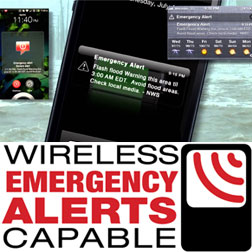September is recognized as National Preparedness Month (NPM) which serves as a reminder for everyone to prepare disasters and emergencies. There are plenty of resources available at https://www.ready.gov/september but I’m going to simplify what are the exact steps that you should do/if you haven’t done them yet.
National Preparedness Month: 10 simple things you can do right now to become more prepared and resilient.
1. Activate your WEA (Wireless Emergency Alerts).
Wireless Emergency Alerts (WEA) are emergency messages such aa Extreme weather warnings, Local emergencies requiring evacuation or immediate action, AMBER Alerts and Presidential Alerts during a national emergency. No signup is required. Alerts are sent automatically to WEA-capable phones during an emergency.
Many new cell phones are WEA-capable. Prepaid mobile devices may also be WEA-capable. For information about which mobile devices are WEA-capable and carrier participation, please or contact your wireless carrier or visit http://www.ctia.org/wea
2. Create and test emergency communications plans.
Before an emergency happens, have a family discussion to determine who would be your out-of-state point of contact, and where you would meet away from your home — both in the neighborhood and within your town. Download and print your family communication plan here.
3. Assemble or update emergency supplies.
You can also order your Family Disaster Survival Kit for your home, it is the perfect 72 hours Disaster Grab and Go bag for earthquake preparedness for the family.
4. Conduct a drill to practice emergency response actions for local hazards.
5. Participate in a preparedness training or class. We provide Disaster Survival Training Classes, we have trained over 120,000 persons and hundreds of schools and businesses over our 25 years in business. Included are the latest techniques and practices of professional rescuers focused on saving lives while providing everyone with…real world solutions.
6. Collect and safeguard critical documents. When disaster strikes, your immediate concern will be your safety and the safety of those you care about. Once the immediate danger passes, however, having your financial and medical records and important contact information will be crucial to help you start the recovery process quickly. Taking time now to safeguard these critical documents will give you peace of mind, ensure you have access to essential medical and prescription information, and help you avoid additional stress during the difficult days following a disaster. Read the Be Smart. Protect Your Critical Documents and Valuables checklist identifies the financial and legal documentation, medical information, and household identification you may need following a disaster. Ensure that your organization’s critical documents and operating plans are also safeguarded to guarantee operational continuity.
7. Document property and obtain appropriate insurance for relevant hazards. Store important documents such as legal paper, birth certificates, passports etc. in a waterproof and fireproof box, safe, or bank deposit box. Leave copies with trusted relatives or friends. Secure electronic copies with strong passwords and save them on a flash or external hard drive in your waterproof box or safe. Store Insurance policy number and contact information nearby. Keep your policy number, your insurance professional/company phone number, and claim filing instructions in a secure, convenient location. You can read the Be Smart. Take Part. Document and Insure Your Property checklist can help you get started.
8. Make property improvements to reduce potential injury and property damage. Your home is the center of your life. It’s your small, personal space in a large world. It’s where your children take first steps and say first words, where you rest and rejuvenate, and where you make memories. And if you’re not prepared, one natural disaster can wipe it all away. When you buy a home, you want to protect it. Nothing should take away your sanctuary—not bad weather or unexplainable freak accidents. Read here on how to prepare Home for Natural Disaster(Tornado Earthquake, Wildfires and Flood).
Conduct an exercise or test your emergency plan. Create a team with your friends and neighbors to share the effort.
Plan with neighbors to help each other and share resources.
You may feel overwealmed with all of this steps, so do it one at a time but start it today.



